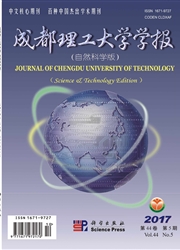

 中文摘要:
中文摘要:
汶川(Ms 8.0)地震驱动的构造抬升作用和滑坡、泥石流剥蚀作用如何影响龙门山的地貌生长是目前争论的焦点。作者以位于汶川地震震中位置的映秀红椿沟泥石流为例,利用野外实测资料、航片和数字高程资料,开展了红椿沟流域汶川地震驱动的构造抬升与滑坡、泥石流的表面侵蚀过程及其对龙门山地貌生长约束方面的定量研究,获得以下初步认识:(1)红椿沟位于汶川地震震中区的高山峡谷,发震断裂——北川断裂从该沟切过。(2)汶川地震触发的同震滑坡体积达3.800 1×10^6 m^3,是震前滑坡量的3倍。(3)2010-08-13和2010-08-18强降雨形成的震后泥石流体积为0.705×10^6 m^3,表明震后强降雨使同震滑坡量的20%转化为泥石流。(4)红椿沟泥石流将0.485×10^6 m^3固体物质输入岷江河道(主河),导致河道变窄、河床升高、河床比降增大。(5)冲入河道量与同震滑坡量之间的转化率约为13%,冲入河道量与泥石流量之间的转化率为70%。(6)在红椿沟流域同震的滑坡体积(3.800 1×10^6 m^3)小于同震的构造抬升体积(6.67×10^6 m^3),仅有约57%的构造抬升量转化为滑坡量,表明以逆冲-走滑作用为特征的汶川地震所导致的构造抬升量大于滑坡量,将使龙门山地貌产生新的抬升和生长。
 英文摘要:
英文摘要:
How the tectonic uplift,landslides,and debris flow erosion driven by the Wenchuan(Ms 8.0)earthquake affect the geomorphic growth of Mt.Longmen is the focus of the debate at present.The aim of this study is to make clear how the mass wasting triggered by the Wenchuan earthquake affect the growth of the Mt.Longmen.Field data,aerial photographs,and digital elevation data are used to conduct quantitative analyses of the tectonic uplift driven by the Wenchuan earthquake and of landslide and debris flow erosion processes,along with their effects on the geomorphic growth of Mt.Longmen.The preliminary insights obtained are as follows.(1)The Hongchun gully is located in alpine valleys within the earthquake epicenter area.The seismogenic fault- the Beichuan fault cuts through the gully.(2)The Wenchuan earthquake triggered the coseismic landslides of 3.800 1×10^6 m^3,being three times the volume before the earthquake.(3)The volume of the debris flow resulting from heavy rainfalls on August 13 and 18,2010 after the earthquake was 0.705×10^6 m^3,indicating that 20% of the volume of the coseismic landslides after the earthquake was changed into debris flows because of heavy rainfalls.(4)The Hongchun gully debris flow discharged solid materials of 0.485×10^6 m^3 into the Minjiang River(the main river),leading the watercourse to be narrowed,the riverbed elevated,and the riverbed gradient increased.(5)The conversion ratio between the sediments input into the watercourse and the coseismic landslide sediments was about 13%.The conversion ratio between the sediments input into the watercourse and the debris flow sediments was 70%.(6)The volume(3.800 1×10^6 m^3)of the coseismic landslides in the Hongchun gully was less than that of the coseismic uplift(6.67×10^6 m^3).Only about 57% of the uplift volume was converted into the landslide volume,indicating agreater volume of the tectonic uplift compared to the volume of the landslides resulting from the Wenchuan earthquake characterized by thr
 同期刊论文项目
同期刊论文项目
 同项目期刊论文
同项目期刊论文
 Surface process and fluvial landform response to the Ms 8.0 Wenchuan Earthquake, Longmen shan, China
Surface process and fluvial landform response to the Ms 8.0 Wenchuan Earthquake, Longmen shan, China Seismotectonic Mechanisms of Lushan (Ms7.0) earthquake in the frontal propagation belt of the Longme
Seismotectonic Mechanisms of Lushan (Ms7.0) earthquake in the frontal propagation belt of the Longme Increased sediment discharge driven by heavy rainfall after Wenchuan earthquake: A case study in the
Increased sediment discharge driven by heavy rainfall after Wenchuan earthquake: A case study in the Crustal thickening or isostatic rebound of orogenic wedge deduced from tectonostratigraphic units in
Crustal thickening or isostatic rebound of orogenic wedge deduced from tectonostratigraphic units in Determination of mean recurrence interval of large earthquakes on the Garzê-Yushu Fault (Dengke Segm
Determination of mean recurrence interval of large earthquakes on the Garzê-Yushu Fault (Dengke Segm Episodic orogeny deduced from coeval sedimentary sequences in the foreland basin and its implication
Episodic orogeny deduced from coeval sedimentary sequences in the foreland basin and its implication Application of the material balance method in paleoelevation recovery: a case study of the Longmen M
Application of the material balance method in paleoelevation recovery: a case study of the Longmen M Tectonic uplift and landslides triggered by the Wenchuan earthquake and constraints on orogenic grow
Tectonic uplift and landslides triggered by the Wenchuan earthquake and constraints on orogenic grow Denudation pattern across the Longriba fault system and implications for the geomorphological evolut
Denudation pattern across the Longriba fault system and implications for the geomorphological evolut Migration of the carbonate ramp and sponge buildup driven by the orogenic wedge advance in the early
Migration of the carbonate ramp and sponge buildup driven by the orogenic wedge advance in the early Preventing and limiting exposure to geo-hazards: Some lessons from two mountain villages destroyed b
Preventing and limiting exposure to geo-hazards: Some lessons from two mountain villages destroyed b The strong motion records of the Ms 8.0 Wenchuan Earthquake by the digital strong earthquake network
The strong motion records of the Ms 8.0 Wenchuan Earthquake by the digital strong earthquake network Spatial relationships between surface ruptures in the Ms 8.0 Earthquake, the Longmen Shan region, Si
Spatial relationships between surface ruptures in the Ms 8.0 Earthquake, the Longmen Shan region, Si Seismotectonic mechanisms of Lushan(Ms7.0) Earthquake in the frontal propagation belt of the Longmen
Seismotectonic mechanisms of Lushan(Ms7.0) Earthquake in the frontal propagation belt of the Longmen The seismogenic structure and deformation mechanism of the Lushan (MW 6.6) earthquake, Sichuan, Chin
The seismogenic structure and deformation mechanism of the Lushan (MW 6.6) earthquake, Sichuan, Chin 期刊信息
期刊信息
